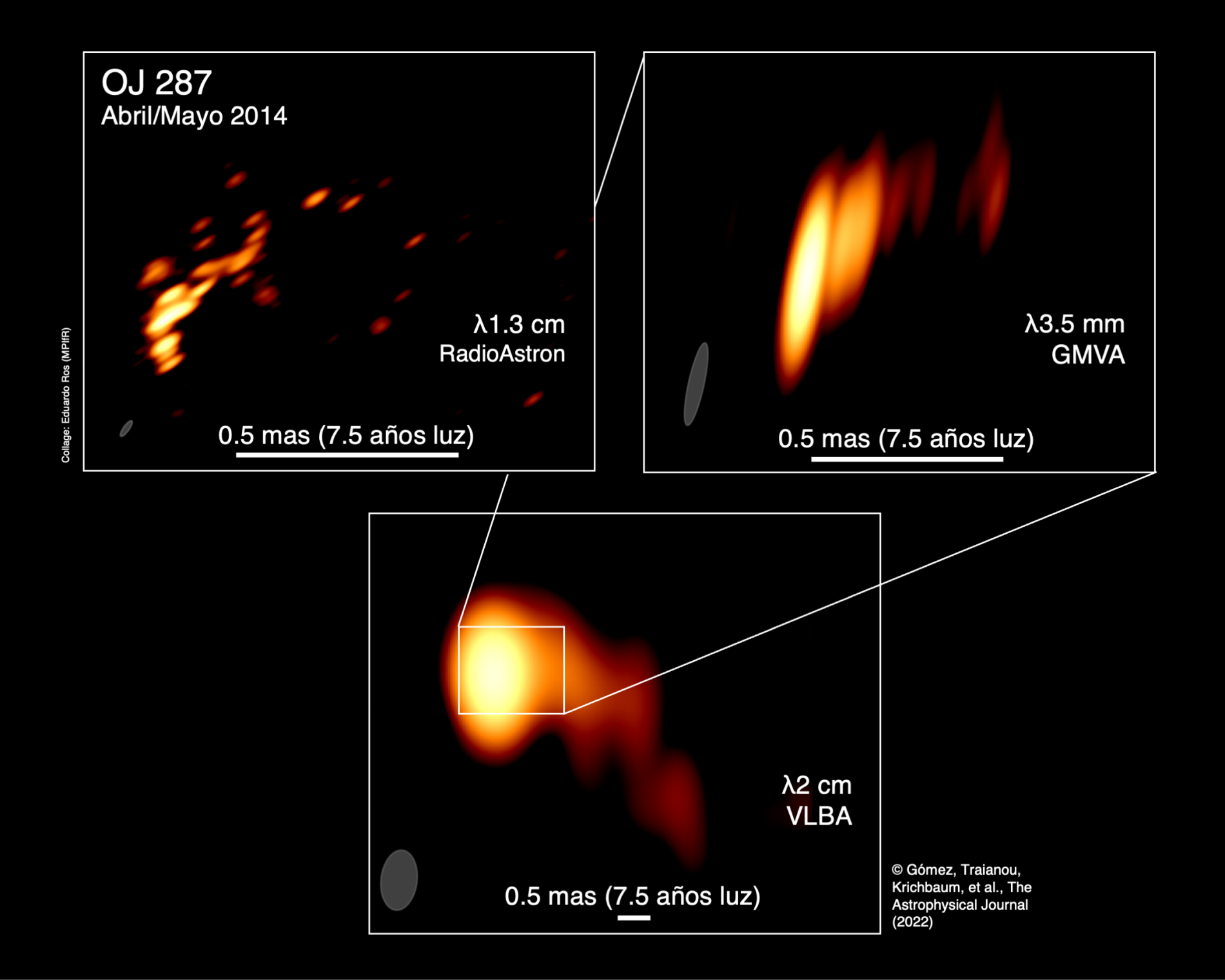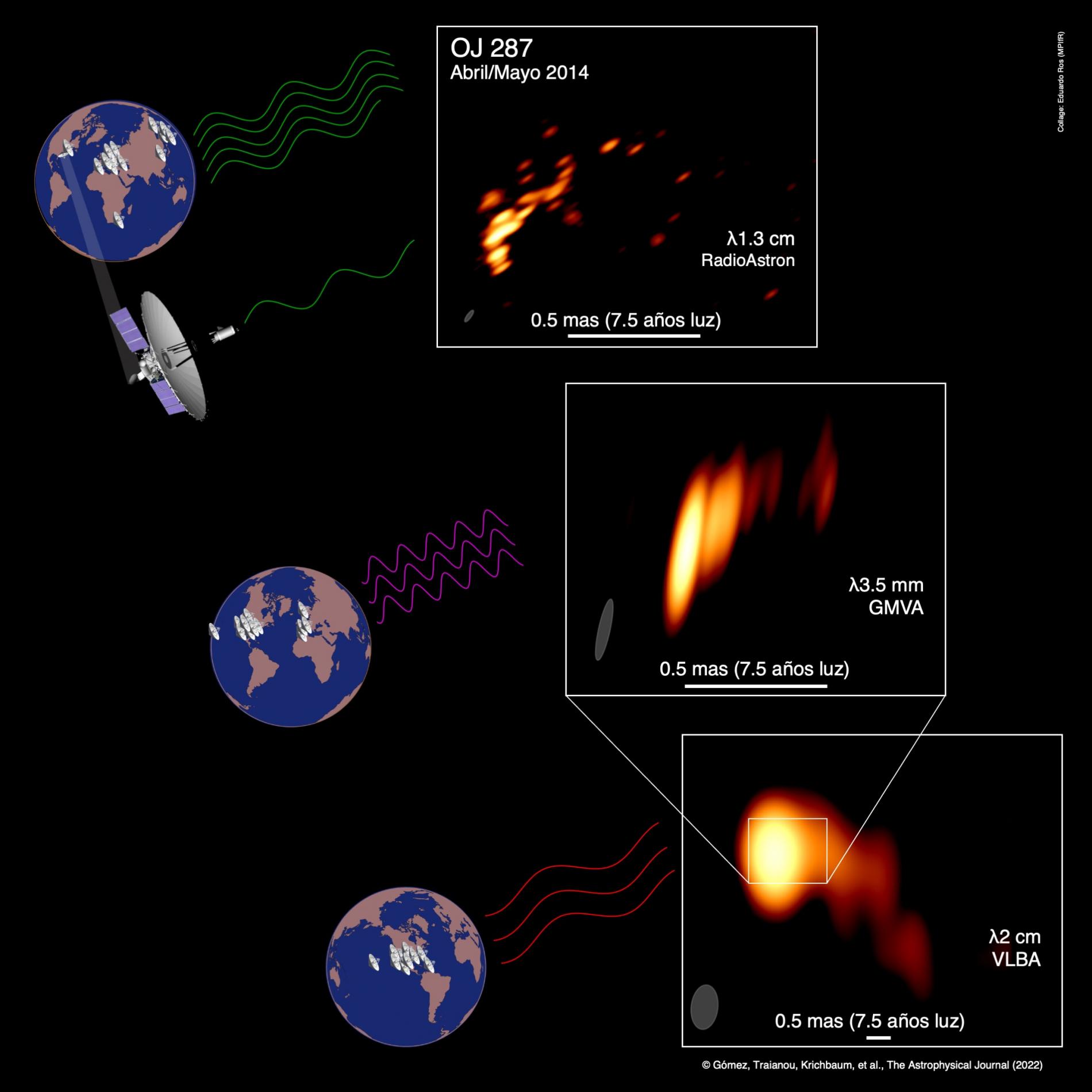Highest resolution image of the OJ 287 galaxy suggests it harbours a binary supermassive black hole
The Institute of Astrophysics of Andalusia (IAA-CSIC) is leading a work that combines observations of space and ground-based radio telescopes to study the central regions of the galaxy OJ 287
The galaxy OJ 287 is not an ordinary object. It belongs to the blazar group, the most powerful sources of continuum radiation in the universe. These objects show a central supermassive black hole surrounded by a disc of gas that feeds it, but they are among the 10% of galaxies that we call active, and among the even smaller percentage that show a jet of matter emerging from both poles at very high speed that we see almost head-on. Moreover, OJ 287 is the only supermassive black hole binary system candidate that we know of in our cosmic neighborhood. Now, an international scientific team led by the IAA-CSIC has obtained the highest resolution image of the central regions of OJ 287 that suggests that we are indeed looking at a unique black-holes dance duet.
Analysis of the data revealed that this spectacular source exhibits a highly curved plasma jet with several knots, or brighter regions, whose nature is unknown. Comparison of space and ground-based observations revealed a progressive curvature of the jet with increasing angular resolution, in agreement with theoretical predictions that OJ 287 harbours not one but two supermassive black holes, with the secondary orbiting the primary and piercing its accretion disc twice every twelve years.
Artist concept of the binary supermassive black hole in OJ 287. Credit: R. Hurt (NASA/JPL) & Abhimanyu Susobhanan (Tata Institute of Fundamental Research).
In addition, the team found that while the energy in the innermost regions of the jet arises from plasma particles, at larger distances it comes from both the particles and the local magnetic field. They also found evidence that the magnetic field in the innermost regions is coiled, in a helical structure that is consistent with jet formation models.
"These results are a step forward in our understanding of the morphology of jets in the vicinity of the central engine. They also confirm the role of magnetic fields in their launch and once again provide indirect evidence for the existence of a binary black hole system at the heart of OJ 287", says Thalia Traianou, a researcher at the Institute of Astrophysics of Andalusia (IAA-CSIC) who participated in the study.

The discovery was made possible thanks to the technique known as very long-baseline interferometry (VLBI), which allows multiple radio telescopes separated geographically to work synchronously, functioning as a telescope with a diameter equivalent to the maximum distance separating them.
In this case, the science team observed OJ 287 with ground-based antennas and in space. The participation of the ten-metre orbiting antenna Spektr-R (RadioAstron mission of the Astro Space Centre in Moscow, supported by the Russian Space Agency) made it possible to create a radio telescope with a diameter fifteen times larger than that of the Earth. The resulting image is equivalent to distinguishing, from the ground, a twenty cent coin on the surface of the Moon. "We have never observed the inner regions of the jet in OJ287 in such fine detail", says Thalia Traianou (IAA-CSIC).
Today, one of the main unknowns related to the formation of supermassive black holes is known as the final parsec problem. The theory suggests that all binary black hole systems will forever maintain a distance of about one parsec (one parsec equals 3.26 light years), due to the difficulty in dissipating angular momentum when the two black holes are isolated from other gravitational interactions, and the separation between them is not small enough for them to emit gravitational waves. The detection and study of gravitational waves emitted by these systems may confirm or rule out this theory.

J. L. Gómez, E. Traianou et al. "Probing the innermost regions of AGN jets and their magnetic fields with RadioAstron. V. Space and ground millimeter-VLBI imaging of OJ 287". Astrophysical Journal, January 2022.
Instituto de Astrofísica de Andalucía (IAA-CSIC)
Unidad de Divulgación y Comunicación
Silbia López de Lacalle - sll[arroba]iaa.es - 958230676
https://www.iaa.csic.es
https://divulgacion.iaa.csic.es

